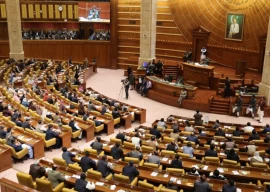Iqbal Salahuddin has a passion for Islamic architecture in Spain, Morocco, Turkey, Iran and the Subcontinent. So when building a mosque in memory of his father, he decided to borrow from them.
“I wanted to incorporate similar colour themes here,” he says, pointing to the hues of blue in the under-construction mosque at a one-kanal site in Salli Town, which is named after his father Mian Salahuddin, the son-in-law of Allama Iqbal.
“The light sky blue signifies the mercy of God and it is used heavily in early Islamic scripture,” says Salahuddin. Dark blue, the colour of the tiles used for the lower half of the verandah walls, signifies mysticism in Islam, he says. A golden and black arch (mehrab) signalling the direction of the Kaaba is inspired by the tomb of Bayazid Bastami in Iran.
There are inspirations from closer to home too. The floral frescoes are modelled on Masjid Wazir Khan and Masjid Bibi Khanum. Architect Kamil Khan Mumtaz, an authority on Mughal architecture, designed the building.
The structure, made of clay and mortar, took about a year to build. “A cement building may last about 200 years but clay structures can last over a thousand years,” says Salahuddin.
“Using clay and mortar in place of steel, aluminium, cement and glass spares the planet,” says Mumtaz. “There is no pollution, no need to import materials and hence no destruction of the environment.”
The basic structure was put up in about a year, but work on the mosque has been ongoing for five years. “Finding the right tiles and the right artists to paint the frescoes was an arduous task,” Salahuddin says.
These artists are Ustad Rafaqat Ali Naqqash and his sons Shafqat Ali and Majid Ali. They have been working on the Salli Town mosque for the last two years. They have finished some frescoes on the walls on the inside and are currently working on the ceilings.
Since starting his craft in 1971, Naqqash has worked on Shalamar Gardens, Khawabgah and Sheesh Mahal at the Lahore Fort, Masjid Wazir Khan and Marium Masjid near Sheranwala Gate in the Walled City.
He says painting new frescoes is easier than repairing old ones. “Restoration requires finding the exact shade used in the original and careful application of the paint to the existing fresco. This is much harder than designing and painting from the beginning,” he says. Salahuddin purchased some tiles for the mosque from Nasirpur, Sindh. “It was the only place making traditional geometric patterned tiles,” he says. However, unsatisfied with the quality, he requested Clayware, a company specialising in traditional pottery designs, to manufacture the tiles.
Pointing to patterned tiles bordering the domes and highlighting the boundary wall, he says these were produced by Clayware specifically for the mosque. Terracotta tiles that will form the mosque’s floors are yet to be installed.
He is hopeful the mosque, which will have a capacity for 500 worshippers, will be completed between December and March 2013.
Mumtaz, though, does not expect others to follow them in adopting Mughal era techniques to build. “Modern developers do not appreciate the historical appeal of buildings and these techniques are labour intensive. That means the poor make money. Developers are interested in their own profits only.”
Published in The Express Tribune, July 3rd, 2012.
COMMENTS (18)
Comments are moderated and generally will be posted if they are on-topic and not abusive.
For more information, please see our Comments FAQ
1732071267-0/lana-(2)1732071267-0-405x300.webp)
1727242355-0/Diddy-(1)1727242355-0-165x106.webp)

1732063440-0/elon-(3)1732063440-0-165x106.webp)













Robert Hillenbrand, Professor of Islamic Art at the University of Edinburgh, has this to say in his well-known book ‘Islamic Architecture’ (1994):
‘Throughout this book … ‘Islamic’ should be taken to refer to both a religious and a cultural entity, and thus to embrace caravansarais, bridges, cities and other forms of secular architecture just as much as religious buildings…. ‘Islamic’ will work satisfactorily also because, to a remarkable extent, Islamic architecture does have a distinctive quality….’
For a more philosophical justification of the term Islamic this link might be useful: http://kamilkhanmumtaz.blogspot.com/2010/08/mithaal-e-mulk-e-abad-time-less-message.html
Let's leave @Awan alone and congratulate Iqbal Salahuddin for the painstaking effort he is making in producing something that is both aesthetically pleasing and exquisitely detailed. Whatever architecture you want to call it, the people of Salli town will have a lovely mosque that others will come from afar, to see and pray in.
@Awans: You obviously have very little idea of the religious significance of the majority of historical architecture. Kindly read up on this issue before giving "your view" on millenia of historical progression.
Currently in present times you might have a point, but please don't attempt to redefine the entire history of architecture for your own justifications.
@Javed Khan: Yes I am Persistent with my Statement that Architecture is a way of design of a certain group of people which they adapt overtime and the skills they harness to develop certain aspects that are peculiar to them than anyone else. Nowhere in our Religion Islam or even in Christianity it is written that there is some Peculiar Architecture associated with any Religion.! Architecture in my view should be associated with a Certain Civilization rather than with One Religion. If new modern Architecture of West is Considered Western and it includes People who are Muslim as well then why not it should be the same for the Eastern Architecture?.
@Awans: So the Museum of Islamic Art in Doha, Qatar got it wrong?
@Awans:
There are tens of thousands of books published with the title "Islamic Architecture" around the world. Lectures on "Islamic Architecture" are taught as part of architecture courses in universities around the world. And you are claiming that there is no such thing as "Islamic Architecture". It was Islam that gave Arabs most of their culture and architecture. In fact, there's no such thing as "Arab architecture". Your statement just exposes your anti-Islamic beliefs.
@Awans:
Do you know that all Cathedrals in the west are shaped like a cross when seen from above? And you are saying that architecture has nothing to do with religion?
We dont see this form of construction in Pakistan anymore, especially using asthetic design and maintaining the heritage. Good to see this being practised in an era of concrete jungle.
@ Awans
such a stupid comment you have made. And those who have liked your comment are even more stupid.
I am an architecture student and I can vouch for the authenticity of Islamic Architecture. If you want to add some more knowledge to your ignorance than check out this link:
http://web.mit.edu/akpia/www/page002.htm
http://agakhan.fas.harvard.edu/icb/icb.do
These are the Islamic Architecture programs taught in MIT and Harvard.
Islamic Architecture is a completely different science in Architecture. It is so thorough and have so many aspects of Islam in it, does not matter from which part of the Islamic world you talk about, certain elements are so common to all that is why it is called Islamic Architecture.
Please take your comment back. It is a height of ignorance.
@Awans:
What's Arab architecture?
@Awans: please Google before you comment, as there are exhibitions of Islamic Architecrue and taught as subject in UK. Islamic means coming from culture of Islam followers, not as a message from heaven. Victoria and Albert museum do exhibitions on Islamic art and culture, without the fear of any muslim sitting in south east asia assuming it 'religious'.
Dude there is Islamic architecture. I read books on history of arts in my high school and it says Islamic architecture and influence and also there is islamic influences. By the way there too is Christian influence from the Christo-judeo age and influences taken from ancient cathedrals and whatever
@Awans: You are just obsessed with anti-Islamism. Islamic Architecture is a complete science of Architectural field. In US, where I live, people graduate with their focus on "Islamic Architecture". The reason it was named so is because of the specific way the buildings were being built across the globe by different ethnic groups across various different countries in the world. The only thing common in those designs was Islam. That is why it is called Islamic Architecture.
As for "what will you do" part, I would say please just get a life and stop being wanna-be progressive by christian vs islamic thinking.
@Awans: True... technically it is "Perso-Mughal" architecture.
Amazing construction
Beautiful, prestigious and glorious. A model project, very well done Iqbal Salahuddin and team. I wish you guys all the very best and pray that Mian Salli's soul rests in peace.
Wondwefull idea great peoples allways do great things god bless Allama Iqbal and his family.
I think Architecture should not be associated with any religion. If from tomorrow Western countries will start saying that Western Architecture is Christian Architecture then what you will do????. Dont be so possessive and dont bloat so much on the past and peep into the future rather than foraging for your so called lost Pride. In Arab States Islamic architecture is known as Arab Architecture and if Some Iranian or Pakistani will say it Islamic architecture then they really give you a smirk and then tell in not so nice manner that It is Arab architecture rather than Muslim Architecture. So please stop this Possession of Arts and terming it that it belongs to some Religion.